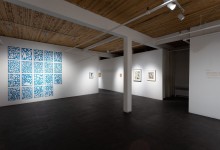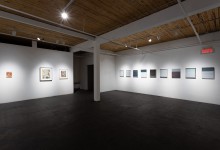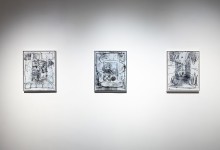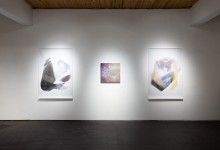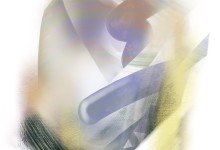Echo: Charlene Hahne, Franziska Holstein, Franz Jyrch, Etienne Lafrance, James Low, Christine Nobel, Maria Schumacher, Matt Schust, Julia Lia Walter
As part of the event Pictura Montreal
Curator: Trevor Kiernander
Text by Trevor Kiernander
Echo brings together the works of nine artists hailing from Canada, Germany, and the UK, all of whom have devoted themselves to the practice of abstract painting. Each of these exceptional artists deals with abstraction through their own systems and personal language, making reference and connections to their environment, where images and ideas are bounced around through their process, reflected and reinterpreted, until reaching a point of completion that becomes part of the entire system once again. The works of each artist reference trace, memory, reflection, and residue – they echo.
One of the most interesting aspects of the work included in Echo is the size of the paintings. Abstraction has a long history of monumental paintings, but the work here is predominantly of a more compact scale. Perhaps this is an indication of the availability of space in constantly redeveloped urban areas, and due to the working conditions, but these smaller works have a particular intimacy to them, not often communicable by massive, imposing abstract paintings.
Charlene Hahne’s two large suspended works are the exception here in scale, but even so, the delicately stained, marked, and sewn pieces have a controlled sensitivity. In these tapestry-like works, the quietness beckons you to look and listen closer.
In her series of nineteen works, Franziska Holstein updates and reuses her own forms from previous projects, reconfiguring them in simple blue and white, like snapshots of an extensive historical body of work, each coded with a unique message within. In the nine paintings of Matt Schust, residual traces of formalism, colour-field painting, and minimalism are captured in this muted series, each offering a strong insight into a long-standing historical precedent. The expansive gridded paintings of Christine Nobel emanate visual white noise through the use of many colours of the spectrum, developing a starting point into an infinite space guided by both light and rhythm. Nothing is Going My Way, the titles given to Maria Schumacher’s series of one-shot process ‘action abstractions’, tell a tale of the artist’s constant quest, a Sisyphean task of erasure, repainting, and repeating. James Low’s paintings optically vibrate, through his method of painting with various styles and applications sometimes on both sides of a translucent canvas, pushing the language of abstraction that much further through the juxtaposition of recognizable images that hover in the vastness of the colour field which they inhabit. The spatial illusions created by Julia Lia Walter’s digital paintings, come in and out of focus, like driving through a thick fog, or watching the dust settle around you, while Étienne Lafrance’s ‘pop-ups’, collaged works perched atop traditional white gallery plinths, feel like painted gestures frozen in time, like Harold Edgerton’s photo Milk Drop Coronet. In Franz Jyrch’s Stick, ‘painting’ has been deconstructed, where stretcher bars hold multi-coloured rubber gloves in a manner that is both heroic and threatening.
The best abstraction today, of which these works are examples, hold as much power and information as their historical predecessors, but speak not so much about grandiose statements, but more subtle affirmations: less is more. Such a sentiment seems more important than ever with our super-sized and super-sped-up world, and something we need to listen closely to, how it rings out over the distance of time, just as an echo trails off from its initiating event.


